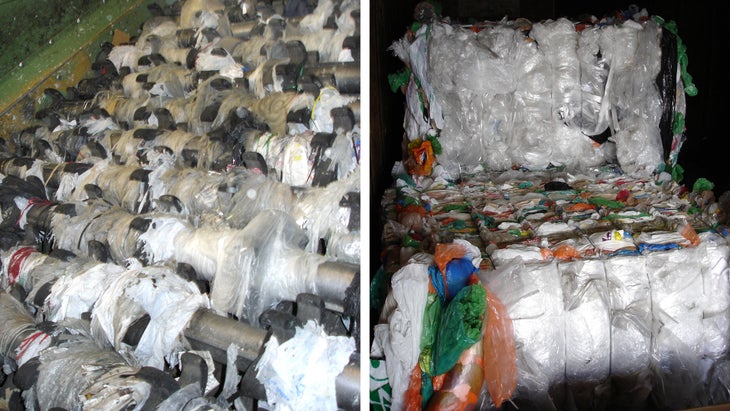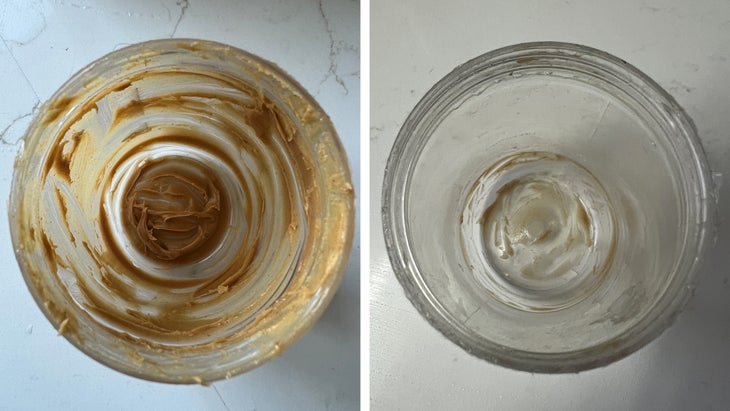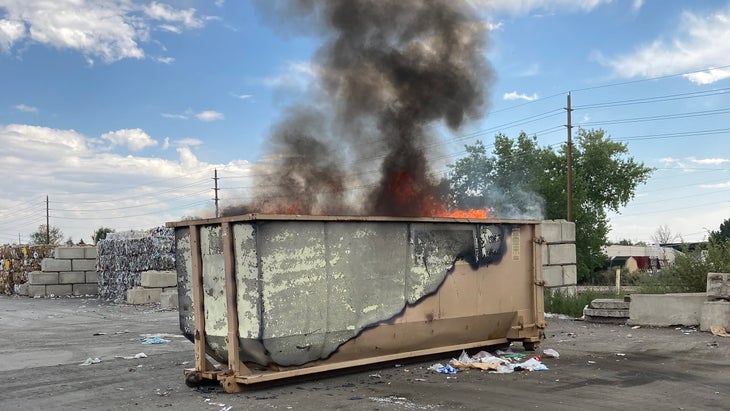Doing right by the planet can make you happier, healthier, and—yes—wealthier. Outside’s Head of Sustainability, Kristin Hostetter, explores small lifestyle tweaks that can make a big impact. Write to her at [email protected].
I’m standing in front of my recycling bin holding an empty cardboard carton of organic milk. I want to recycle it. Part of the reason I bought this milk, which was about a buck more than the stuff in the plastic jug, is that for several years now I’ve been waging a war against plastic in both my personal and professional life.
Cardboard is one of the most recyclable materials in the world. But a little voice inside my head is nagging, “What about that plastic coating on the inside? Does it matter? It’s still mostly cardboard…right?”
I hope for the best, drop it in the bin, and just like that, I’ve “wishcycled.”
Turns out, my cardboard milk container is not recyclable here in northern Vermont, despite the carton’s How2Recycle label advice. But if I saved it and brought it to my mom’s house in Massachusetts, I could throw it in her bin. (Want to know if you can curbside-recycle cardboard milk and juice containers? Plug your address in here.)
Wishcycling is when you put something in the recycle bin because you want to recycle it. You hope it will get turned into some shiny new object. But you don’t really know if it will and so you decide to let someone else down the line figure it out for you.
Your intentions are good, but you’re actually creating a huge pain in the ass for recycling facilities.
Wishcycling Versus Reality
“Wishcycling adds financial, labor, and environmental burdens throughout every recycling system around the world,” says Michele Morris, director of marketing and communications of the Chittendon Solid Waste District in Vermont, which owns the recycling facility near my home in Stowe, Vermont. “A worker will have to manually pull that thing off the conveyor belt and send it to the landfill, when you could have made that choice and avoided all those impacts throughout the process.” Morris says she sees some wild items come through the facility: shoes, bicycle tires, garden hoses, styrofoam coolers, plastic toys, and even the odd bowling ball or two.
The antidote to wishcycling is pretty simple: Don’t make assumptions and take the time to learn which items are recyclable in your area. I googled “town dump Stowe Vermont” and found this page which has a tab spelling out what I can recycle where I live.
There’s no magic Google phrase for all locales, though. If you live in a city, say Chicago, try “recycling Chicago.” Within a few clicks you’ll find what you need. If you have specific questions not answered there, find the contact page and pick up the phone. “What’s accepted in your area depends on how far you are from processors and how much recycling your community generates, among other factors,” says Morris. “All these can vary not just regionally, but even within one state.” Some examples of things that can vary region by region: different types of plastics, and yes, those milk cartons.
“People love to say that recycling is broken,” says Stefanie Valenti, editorial director of Waste360. “It’s not, but it is disjointed. The infrastructure hasn’t evolved along with all the different types of materials, mainly plastics, that have come out. The waste management industry is investing lots of money in improving its logistics, but it’s a slow process.”
The whole concept of recycling is based on economics. Recycling was a $2.9 billion business in 2020 and like all markets, it’s based on supply and demand. There’s big demand for certain types of materials, like cardboard Amazon boxes and plastic Miracle Whip jars. But for some materials—like milk cartons—there are fewer processors who can break down the multi-layered material and therefore less of a recycling market for it.
“When in doubt, give a shout or throw it out,” says Morris. “Learn the rules where you live and have faith that those rules are designed to capture the most important and impactful materials while keeping out the undesirable stuff. If you’re not sure, trash it.”
I think back to the thousands of recycling blunders I’ve made over the years: the unused plastic cutlery from Yum Yum Thai, the Scotch tape dispensers, the chipped pint glasses. (Yes, all of those things are no-no’s according to “the container rule,” below.)
But according to Morris, we shouldn’t sweat the small stuff. If we all focused on what she calls “The Big Five” most common recycling mistakes, it would be a huge win for the recycling world and the planet.
The Big Five Curbside Recycling Mistakes
Plastic Bags
Filmy plastic (aka “soft film”) of any kind, including zipper-locks, bubble wrap, plastic padded Amazon envelopes, garbage bags, wrap from toilet paper, and bread bags, don’t work in any single-stream recycling system.

Why it’s a problem: Soft film jams machinery. Workers have to hit the kill switch on the whole operation and manually pull it out of the system. It can also tangle up with other valuable recyclables and then the whole mess gets landfilled rather than sold and repurposed. And if you bag perfectly good recyclables, like plastic water bottles and paper, the whole bag will get landfilled because workers don’t have the bandwidth to unbag and sort them.
The solution: Many grocery stores across the country accept soft film and recycle it properly. Find a local market by entering your zip code here.
Un-Rinsed Containers
Why it’s a problem: Two reasons: Old peanut butter and congealed sauce from your General Tso chicken degrades the value of the material you’re recycling (which defeats the whole purpose). And it can also pose health and safety risks to human workers who have to handle the nastiness and deal with the rats and wasps that get attracted to the facility.

The solution: Give your stuff a quick rinse (no need for soap or elbow grease) to remove the majority of the gunk. Or better yet, save water and give your pet another reason to love you. Dogs and cats do a very good job of licking food containers clean.
Rigid Plastic
Single-stream recycling is designed to take rigid, single-use plastic containers from food, drinks, and nonhazardous cleaning materials like shampoo and laundry soap. But don’t assume all plastic is single-stream recyclable. On most plastic, you can find a number inside a triangle of chasing arrows or letters next to it (like PET or HDPE). The numbers and letters, called Resin Identification Codes (or RICs) indicate the type of plastic, but they were never designed for consumer education. “They were created for end-market recyclers and processors to ensure consistency within each bale of materials,” says Morris.
Morris suggests ignoring the numbers and instead getting familiar with your local recycling rules. She says a good general approach is using the container rule, which simply means single-use rigid plastic containers only, like water, soda, and salad dressing bottles, salad containers, and shampoo bottles. The system isn’t designed to take durable plastic items like storage bins, flip-flops, pens, toys, sunglasses, or hampers because items need to be sorted and baled with like products. The recycler can’t collect enough pens, for instance, to create a marketable 35,000-pound load for them to sell. “On the other hand, we know that the overwhelming majority of containers we get will be the types of plastics we want—the types we can sell to processors to be turned into new raw materials.”
Why it’s a problem: While almost anything is technically recyclable, in real world terms there are a bunch of factors at play. First, Morris says, you need to have enough homogenous material (supply) to make it worthwhile from a labor, cost, and space perspective for the facility to collect. Next, you need a recycler willing and able to sort and bale that material. Then you need a marketer to collect the bales and sell it to processors. And finally, you need a processor willing to buy the material (demand) at a cost that sufficiently pays everyone along the supply chain for their labor and transportation and still nets a profit for them. “That’s why we target the common items. We know there is supply and we know there is demand,” she says.
The solution: Ask yourself, “Is this a single-use container?” If yes, bin it, regardless of the numbers or letters inside the arrows. If not, trash it. And try to avoid buying anything plastic if you can.
Scrap Metal
The container rule applies here, too. Only empty metal food, drink, and nonhazardous cleaning materials containers belong in your bin, like drink, soup, and olive oil cans.
Why it’s a problem: Other metal objects like silverware, bottle caps, metal jar lids, blades from safety razors, and wire hangers can be extremely dangerous for workers and damage recycling machinery.
The solution: Save those items and find a local scrap metal recycler (just Google it!). Metal has value—you might even make a few bucks.
Batteries
Batteries—especially lithium ions—are huge no-nos for curbside recycling and have caused a remarkable number of fires at recycling facilities, landfills, transfer stations, and even during transport.

Why it’s a problem: Batteries are extremely sensitive to heat and friction. And, trust me, there’s a whole lot of friction going on at recycling centers. Think: complex mazes of converter belts, metal teeth, grinding gears, vibrating steel mesh, and high-powered magnets and vacuums.)
The solution: Save them in a box and ask your town or local recycling center for the nearest drop-off.
Kristin Hostetter is the Head of Sustainability at Outside Interactive, Inc. and the resident sustainability columnist on Outside Online.
